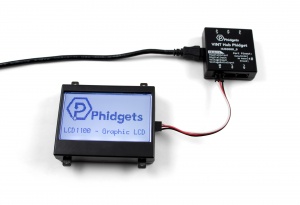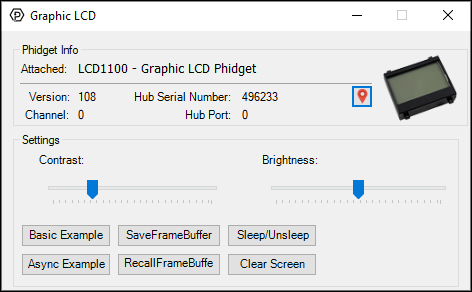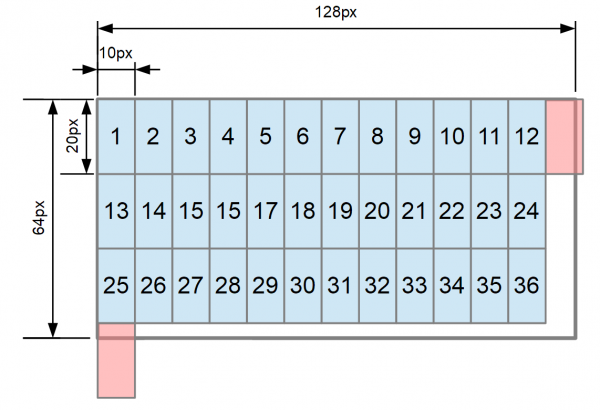LCD1100 User Guide: Difference between revisions
No edit summary |
|||
| Line 27: | Line 27: | ||
==Technical Section== | ==Technical Section== | ||
===Custom Characters=== | |||
Custom characters on the LCD1100 are stored as images on the frame buffer for their font. | |||
<code>FONT_User1</code> is stored on frame buffer 1 and <code>FONT_User2</code> is on frame buffer 2. | |||
Characters for each font are stored in rows ordered left-to-right, top-to-bottom. | |||
Rows are filled with as many characters as will completely fit across the width | |||
of the screen, and there are as many rows as will fit on the screen vertically. | |||
On a screen 128 pixels wide by 64 pixels high, if your font is 10 pixels wide by 20 high, you will have 3 rows of 12 characters. This allows for a maximum of 36 characters of that size. | |||
[[image: LCD1100_CustomCharacterCount.png|thumb|center|upright=2|<center>A demonstration of how many 10x20px characters can fit on the screen.</center>]] | |||
To quickly assess how many characters can be in your custom font, you can call | |||
<code>getMaxCharacters()</code> in your code. | |||
Custom characters start with index 1 and can be any index between 1 and the maximum | |||
number of characters that fit on screen. | |||
To determine if an ascii character can be used in a given custom font, you can | |||
look at its corresponding ascii value on an ascii chart to determine if it is within | |||
the limit determined above. | |||
{{UGnext|}} | {{UGnext|}} | ||
Revision as of 18:37, 7 February 2018

Required Hardware
- An LCD1100 Graphic LCD Phidget
- A 3-wire Phidget cable
- A VINT Hub
- A USB cable
- A computer
Connecting the Pieces
- Connect the LCD1100 to the VINT Hub using the Phidget cable.
- Connect the VINT Hub to your computer with a USB cable.
Testing Using Windows
Phidget Control Panel
In order to demonstrate the functionality of the LCD1100, the Phidget Control Panel running on a Windows machine will be used.
The Phidget Control Panel is available for use on both macOS and Windows machines.
Windows
To open the Phidget Control Panel on Windows, find the ![]() icon in the taskbar. If it is not there, open up the start menu and search for Phidget Control Panel
icon in the taskbar. If it is not there, open up the start menu and search for Phidget Control Panel
macOS
To open the Phidget Control Panel on macOS, open Finder and navigate to the Phidget Control Panel in the Applications list. Double click on the ![]() icon to bring up the Phidget Control Panel.
icon to bring up the Phidget Control Panel.
For more information, take a look at the getting started guide for your operating system:
Linux users can follow the getting started with Linux guide and continue reading here for more information about the LCD1100.
First Look
After plugging the LCD1100 into your computer and opening the Phidget Control Panel, you will see something like this:

The Phidget Control Panel will list all connected Phidgets and associated objects, as well as the following information:
- Serial number: allows you to differentiate between similar Phidgets.
- Channel: allows you to differentiate between similar objects on a Phidget.
- Version number: corresponds to the firmware version your Phidget is running. If your Phidget is listed in red, your firmware is out of date. Update the firmware by double-clicking the entry.
The Phidget Control Panel can also be used to test your device. Double-clicking on an object will open an example.
Graphic LCD

When you double click on a Graphic LCD object, a window like the one pictured will open.
- At the top of the window, information about your device and the properties of this particular channel will be listed.
- In the middle, brightness and contrast of the LCD screen can be adjusted.
- At the bottom, there are a number of buttons to demonstrate the functionality of the graphics LCD:
- Basic Example: Write some text, lines, boxes and a bitmap to the screen.
- SaveFrameBuffer: Save the current screen to memory.
- RecallFrameBuffer: Load the saved screen from memory and print it to the screen.
- Async Example: Prints a bitmap to the screen asynchronously (can occur while other draw functions are still running).
- Sleep/Unsleep: Toggles sleep mode, where the Phidget is still attached but in a minimal power consumption state.
- Clear Screen: Erases the screen.
Testing Using macOS
- Go to the Quick Downloads section on the macOS page.
- Download and run the Phidget macOS Installer
- Click on System Preferences >> Phidgets (under Other) to activate the Preference Pane
- Make sure your device is properly attached
- Double click on your device's objects in the listing to open them. The Preference Pane and examples will function very similarly to the ones described above in the Windows section.
Testing Using Linux
For a general step-by-step guide on getting Phidgets running on Linux, see the Linux page.
Using a Remote OS
We recommend testing your Phidget on a desktop OS before moving on to remote OS. Once you've tested your Phidget, you can go to the PhidgetSBC, or iOS pages to learn how to proceed.
Technical Section
Custom Characters
Custom characters on the LCD1100 are stored as images on the frame buffer for their font.
FONT_User1 is stored on frame buffer 1 and FONT_User2 is on frame buffer 2.
Characters for each font are stored in rows ordered left-to-right, top-to-bottom. Rows are filled with as many characters as will completely fit across the width of the screen, and there are as many rows as will fit on the screen vertically.
On a screen 128 pixels wide by 64 pixels high, if your font is 10 pixels wide by 20 high, you will have 3 rows of 12 characters. This allows for a maximum of 36 characters of that size.
To quickly assess how many characters can be in your custom font, you can call
getMaxCharacters() in your code.
Custom characters start with index 1 and can be any index between 1 and the maximum number of characters that fit on screen.
To determine if an ascii character can be used in a given custom font, you can look at its corresponding ascii value on an ascii chart to determine if it is within the limit determined above.
What to do Next
- Programming Languages - Find your preferred programming language here and learn how to write your own code with Phidgets!
- Phidget Programming Basics - Once you have set up Phidgets to work with your programming environment, we recommend you read our page on to learn the fundamentals of programming with Phidgets.

